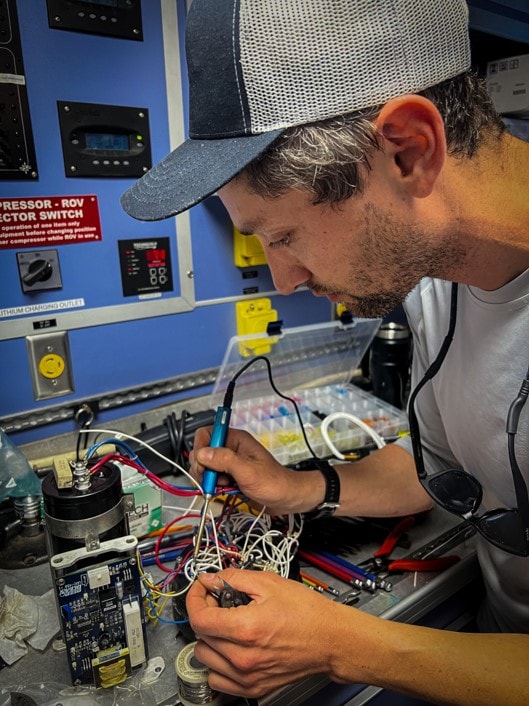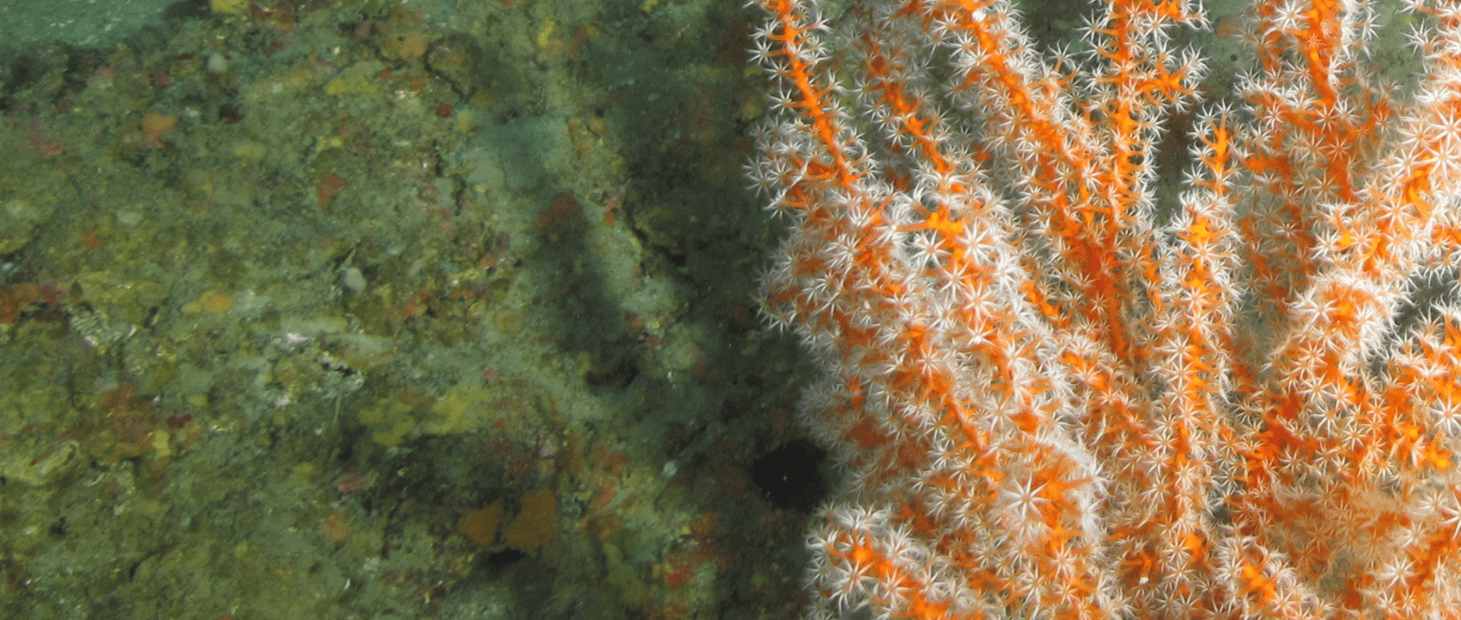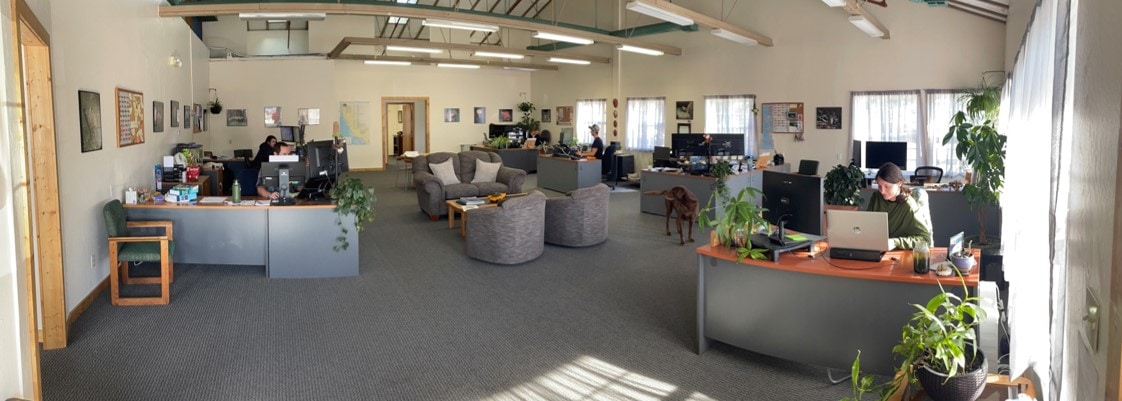EXPLORE
DISCOVER
PROTECT

MARINE APPLIED RESEARCH AND EXPLORATION
2022 IMPACT REPORT
EXPLORE
DISCOVER
PROTECT

MARINE APPLIED RESEARCH AND EXPLORATION
2022 IMPACT REPORT
LETTER FROM THE CHAIR, Board of Directors
 This fall, the Board of Directors had the opportunity to tour MARE’s impressive new Blue Lake facility, an inviting workspace bustling with activity where the team can prepare for upcoming missions and develop new capabilities. Among the capabilities we were able to experience firsthand was MARE’s proprietary data processing workflow, an impressive state-of-the-art process that converts raw video into useful results accurately and efficiently. For example, these results, when combined over multiple survey years, yield trends which will help guide the management of California’s marine resources during the upcoming decadal review.
This fall, the Board of Directors had the opportunity to tour MARE’s impressive new Blue Lake facility, an inviting workspace bustling with activity where the team can prepare for upcoming missions and develop new capabilities. Among the capabilities we were able to experience firsthand was MARE’s proprietary data processing workflow, an impressive state-of-the-art process that converts raw video into useful results accurately and efficiently. For example, these results, when combined over multiple survey years, yield trends which will help guide the management of California’s marine resources during the upcoming decadal review.
For nearly 20 years MARE has immersed itself in the hard work of exploring and documenting our shared ocean, supporting a data-driven approach to conservation and management. Due to the grit of this dedicated and growing team, 2022 was yet another year of unprecedented impact for MARE – and thanks to continued investment in new capabilities such as those we saw in Blue Lake, we are just setting the stage for further expansion in upcoming years. Looking forward to 2023, we plan to procure a new ROV (“Beagle 2.0”) and to develop the ability to conduct multiple missions simultaneously – key enablers for future growth.
As we continue to learn about the threats of human activity to our shared ocean, our mission has never been more important. On behalf of the Board of Directors, we invite you to support MARE and join us as we pursue our vision for a thriving ocean.

Jon Glassman, Chair – Board of Directors
LETTER FROM THE, Executive Director
 MARE began with a singular goal in 2003: to gain critical knowledge about our unexplored deep sea in order to better steward it. The impetus was California’s Marine Protection Act and Long-term Monitoring Program. With thanks to our generous donors and strong partners, we have been able to leverage MARE’s lessons learned with our data analysis techniques to impact far beyond California’s shores.
MARE began with a singular goal in 2003: to gain critical knowledge about our unexplored deep sea in order to better steward it. The impetus was California’s Marine Protection Act and Long-term Monitoring Program. With thanks to our generous donors and strong partners, we have been able to leverage MARE’s lessons learned with our data analysis techniques to impact far beyond California’s shores.
2022 has been an especially exciting year of expansion for MARE. From Guam to Chile, to the Gulf of Mexico and Cape Canaveral, we sampled and documented deep-sea corals, surveyed fish, invertebrates and habitats, and characterized areas that had never before been seen by humans.
Our work will impact remediation efforts for the 2010 Deepwater Horizon oil spill, planning for offshore wind turbine sites in Oregon, and marine ecosystem conservation across the globe. In Chile, we will share our knowledge to help them develop a monitoring program for their fledgling Marine Reserves. As I write this, we are planning another expedition in Costa Rica to perform more shark research with the non-profit Pretoma.
Together, we have gained incredibly important information about our deep sea. In some ways, it’s a drop in the ocean. There is still so much more to do. Next year, on 5 May 2023, we will celebrate 20 years (!) of Marine Applied Research & Exploration. Fueled by a passionate Board of Directors, generous supporters, and masterful partners, MARE is more committed than ever to work towards our shared goals to better understand our ocean in order to protect it.

Dirk Rosen, Executive Director
Technological Innovations
OUR CUTTING EDGE SOLUTIONS



Equipment Upgrades: Expanded Sampling Capabilities
Our engineering team has been busy this year designing and building new equipment to increase our sampling capabilities. Upgrades such as an innovative specimen collection box and suction sampler have been integrated into a new detachable ‘sampling skid’ for the ROV Beagle. These additions greatly increase our ability to collect a myriad of physical samples. Sample collections include sediment and biological specimens that our partners need for analysis and in order to propagate corals intended for restoration out-planting. The designs incorporate multiple compartments to keep specimens separate for DNA analysis.


At Sea
OUR SCIENCE

DEMAND FOR DATA: Marine Protected Areas & Continued Long-Term Monitoring
California’s Marine Protected Areas (MPAs) provide essential long-term protection for important marine ecosystems. As a key player in monitoring the deep subtidal portions of MPAs since 2003, MARE has provided data essential to shaping recommendations for future monitoring strategies.
MARE continued long-term monitoring of California’s Marine Protected Areas (MPAs), surveying over 130 kilometers of sea floor at 47 sites over the past year. Imagery collected, including 6,870 photos and 80 hours of high-definition video, was processed by MARE biologists, along with data collected in 2019 and 2020. Results were then sent to our project partners for detailed statistical analysis. This data enhances scientific understanding of the performance of California’s MPAs and will directly improve the state’s management strategies to effectively conserve critical coastal habitats.

National Marine Sanctuaries
FROM CALIFORNIA TO TEXAS
Greater Farallones & Cordell Bank

The north coast of California boasts 2 national marine sanctuaries encompassing some of the most productive upwelling zones in North America. In the Greater Farallones and Cordell Bank National Marine Sanctuaries, cold water rises from the depths, bringing nutrients and microscopic sea life to the surface. These sanctuaries protect critical habitat for deep-sea corals and sponges, which are the building blocks upon which these ecosystems thrive.
MARE’s work with NOAA’s west coast national marine sanctuaries continued this year, with an expedition to the Greater Farallones and the Cordell Bank National Marine Sanctuaries. In partnership with NOAA, the United States Geological Society, and the California Academy of Sciences, MARE explored deep benthic habitats down to 565 meters deep in waters around the 2 sanctuaries. The purpose of this expedition was to document critical deep-sea coral and sponge habitats, including resampling previously surveyed areas in Cordell Bank and exploring new areas to locate deep-sea corals and sponges in the Greater Farallones.
FLOWER GARDEN BANKS: A Coral Reef Recovery Story

The Gulf of Mexico’s only national marine sanctuary, Flower Garden Banks National Marine Sanctuary is home to diverse shallow water coral reefs and deeper mesophotic reefs full of black coral and octocoral habitats. These are the foundation for a series of interconnected food webs throughout the Gulf.
In 2010, the Deepwater Horizon oil spill spread throughout the Gulf of Mexico, adversely affecting mesophotic and deep benthic communities of organisms on an unknown scale. Since that time, NOAA’s National Centers for Coastal Ocean Science have been part of a team working to improve the understanding of these communities in order to help restore them.
MARE joined NOAA, University of North Carolina, Wilmington and the United States Geological Society on 3 separate expeditions this past year. Our goal was to collect coral samples in order to understand the genetic distribution of these species across the Gulf and to bring home live samples to be propagated and ultimately out planted. Together, we explored over 80 kilometers of sea floor and collected 711 unique coral samples. NOAA scientists hope coral propagation and reintroduction will help to restore important corals and associated benthic ecosystems that have not fully recovered from the collateral impacts of the oil spill.
FLORDIA’S UNIQUE CORAL REEFS: Oculina – A Keystone Species

A-slow growing, delicate coral, Oculina provides essential food, shelter and ideal spawning grounds for many economically important fish and invertebrates including grouper, black sea bass and shrimp.
MARE joined NOAA’s Southeast Fisheries Science Center to look for a critical coral species found in depths of 50 meters or more. Oculina is considered a keystone species in the Oculina Habitat Area of Particular Concern off the east coast of Florida (OHAPC). The OHAPC currently offers protection from trawling and other activities, and this survey helped to evaluate a section along the eastern boundary which is under consideration for reopening to trawling, making this important work. MARE deployed our BATFish towed system down to 110 meters at speeds of up to 6 knots in the Gulfstream. We covered 40 kilometers of habitat and found no signs of Oculina. The information gathered in this survey will help determine which areas should be reopened to fishing.
UNDERWATER ARCHEOLOGY: Making a Difference in the Mariana Islands

MARE had the unique opportunity to partner with Project Recover, a collaborative effort involving Scripps Institute of Oceanography and University of Delaware to use our robotic technology to examine the remains of these aircraft in previously inaccessible depths of over 520 feet. During this 10-day expedition, Scripps mapped the area with autonomous underwater vehicles (AUVs), identifying objects of interest in high resolution. As new targets were located, MARE’s ROV Beagle was deployed to visually inspect these anomalies to determine if they were lost US aircraft. In total, three aircraft were explored. The first two were previously discovered B-29 bombers, while the third, a TBF Avenger, was discovered during this expedition. The TBF Avenger had an intact gun turret, landing gear and wings. With Project Recover’s end goal of bringing lost American soldiers home, we were honored to be a part of this survey.

For decades, due to limitations of existing marine technology, the majority of deep-sea archeological sites remained unexplored. The remains of wreckage sites of United States B-29 bombers in the Northern Mariana Islands are no exception. Launched from the airfields of Saipan and Tinian during WWII, many bombers were lost shortly after takeoff, disappearing into the depths of the ocean.
The Next Generation:
OUR DEEP SEA EDUCATION PROGRAM




Over the 2021-2022 school year in San Francisco Bay Area classrooms, MARE educated, inspired, and empowered a diverse next generation of engineers, scientists, and youth dedicated to a healthy ocean. Our deep-sea education program provided hands-on learning opportunities with real world applications to students, illuminating the critical role science and engineering play in ocean conservation. We bridged learning gaps by bringing no-cost, high-quality STEM education to schools with limited opportunities for STEM learning, including: Livermore, Castro Valley, El Cerrito, and Richmond High Schools and Longfellow Middle School.
Student projects included designing and building an ROV manipulator arm to pick “specimens” up off of the seafloor and development of a new sample collection box (aka “bio-box”) for the ROV Beagle.
Mare Expands:
A NEW OFFICE IN BLUE LAKE

 MARE’S northern California team moved to a new location this past winter. We expanded from a 1,400 square foot office to a 5,500 square foot facility, with over 2,500 square feet of shop/warehouse space. MARE’s robotic fleet and team of engineers made the move from our San Francisco Bay Area office to join our biologists and GIS analysts in this new workspace.
MARE’S northern California team moved to a new location this past winter. We expanded from a 1,400 square foot office to a 5,500 square foot facility, with over 2,500 square feet of shop/warehouse space. MARE’s robotic fleet and team of engineers made the move from our San Francisco Bay Area office to join our biologists and GIS analysts in this new workspace.
From demolition to construction and finishing work, MARE staff performed all of the renovations to transform this old performing arts school into our new expanded facility. We look forward to growing into our new bright and happy workplace!
OUR MISSION
EXPLORE AND DOCUMENT THE OCEAN TO SUPPORT ITS CONSERVATION AND MANAGMENT
OUR IMPACT
AT SEA

Area Explored: 5,125,002 m2
Sites Surveyed: 713
SCIENCE

Fish Identified: 2,113,667
Invertebrates Identified: 3,856,702
TECHNOLOGY

Dives Completed: 1,401
Photographs Taken: 315,591




